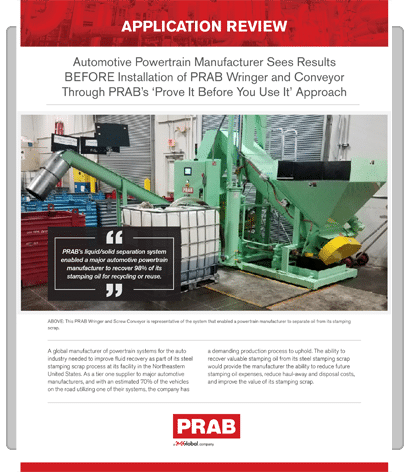
A global manufacturer of powertrain systems for the auto industry needed to improve fluid recovery as part of its steel stamping scrap process at its facility in the Northeastern United States. As a tier one supplier to major automotive manufacturers, and with an estimated 70% of the vehicles on the road utilizing one of their systems, the company has a demanding production process to uphold. The ability to recover valuable stamping oil from its steel stamping scrap would provide the manufacturer the ability to reduce future stamping oil expenses, reduce haul-away and disposal costs, and improve the value of its stamping scrap.
Automotive Industry
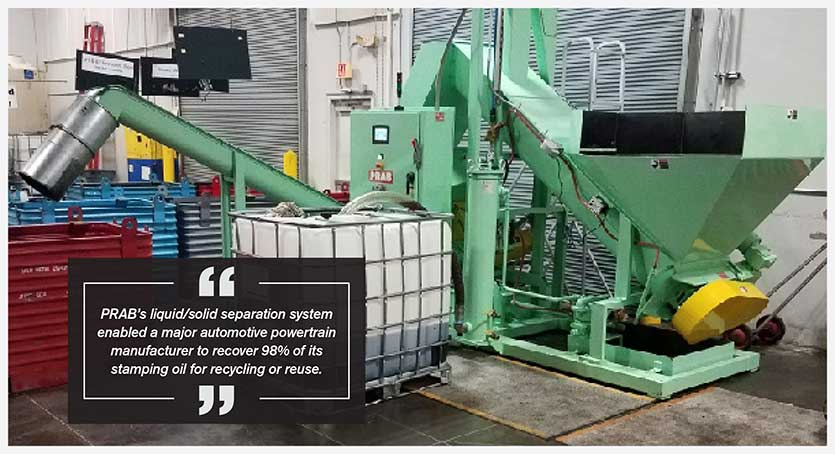
ABOVE: This PRAB Wringer and Screw Conveyor is representative of the system that enabled a powertrain manufacturer to separate oil from its stamping scrap.
PRAB’s liquid/solid separation system enabled a major automotive powertrain manufacturer to recover 98% of its stamping oil for recycling or reuse.
A global manufacturer of powertrain systems for the auto industry needed to improve fluid recovery as part of its steel stamping scrap process at its facility in the Northeastern United States. As a tier one supplier to major automotive manufacturers, and with an estimated 70% of the vehicles on the road utilizing one of their systems, the company has a demanding production process to uphold. The ability to recover valuable stamping oil from its steel stamping scrap would provide the manufacturer the ability to reduce future stamping oil expenses, reduce haul-away and disposal costs, and improve the value of its stamping scrap.

As an existing PRAB customer, the powertrain company was aware of the benefits a PRAB automated solution could bring to its operation. But like most companies that are weighing the benefits of new capital expenditures, the company wanted to quantify the return on investment a new metal scrap processing system would bring prior to purchase and installation of the new equipment. How much fluid would a PRAB system be able to recover? What additional value would a fluid separation system bring? PRAB was able to provide the automotive parts manufacturer with quantifiable answers up-front through its “Prove It Before You Use It” approach to equipment testing.
The powertrain manufacturer’s steel stamping process was producing a scrap mixture containing a 50-50 mix of small steel chips and shells, which were coated in stamping oil. The company needed a system inside its plant that could accommodate 4,000 pounds of material per hour, could be fed by chip carts, would dry the stamping scrap mixture and enable the manufacturer to recover the stamping oil coating the material.
To solve this challenge, PRAB started the process of quoting a liquid/solid separation system that included a diagonal shaft wringer fed by a screw conveyor. To demonstrate the scrap processing system’s capabilities and potential ROI to the customer, PRAB conducted application-specific testing and reporting of the proposed system at its Michigan-based headquarters prior to submitting its final proposal to the powertrain manufacturer.
As part of this value-added service, a PRAB application engineer simulated the powertrain manufacturer’s process for separating its oil from its metal scrap at the PRAB facility utilizing the metal scrap processing equipment that would be installed at the manufacturer’s plant. During the test, the PRAB engineer dumped two 55-gallon barrels of small stamping scrap material provided by the powertrain manufacturer into PRAB’s conveyor in-feed hopper. The material moved up the system’s conveyor and discharged into the PRAB Diagonal Shaft Wringer. The wringer dried the chips and shells and discharged them back into the customer-supplied barrel. The PRAB application engineer documented the following results of the testing:
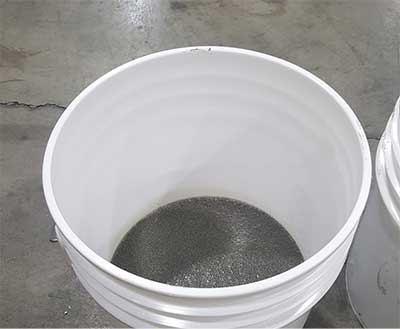
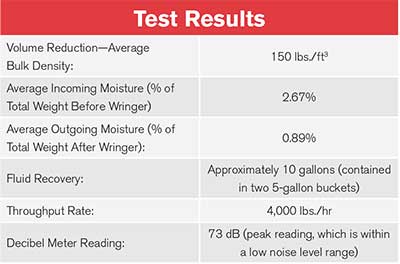
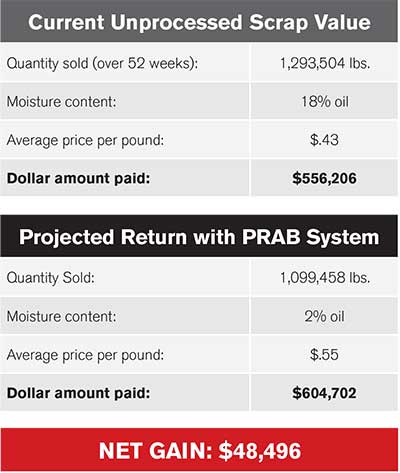
In addition, a major metal recycling company provided an estimate of the projected return on investment for the powertrain supplier’s dry metal scrap:
After reviewing the testing documentation provided by PRAB, the powertrain manufacturer accepted PRAB’s proposed solution. Installed in February 2019, the new metal scrap processing system enables the company to transfer small oil-covered chips and shells from their chip carts into a screw conveyor, which elevates and meter-feeds the metal scrap into a diagonal shaft chip wringer. Using more than 600 G’s of centrifugal force, the wringer separates the oil from the chips and shells. A settling tank captures the reclaimed oil for recycling.
Then, the wringer unloads the processed metal scrap into a discharge conveyor that safely diffuses and vents the generated airflow, and elevates and discharges the wrung material into a swivel chute. This chute enables the manufacturer to achieve more even distribution of fill into the scrap container. The system shuts off when a sensor on the discharge chute indicates a full condition in the discharge container. Further, the system is equipped with a sensor in the in-feed hopper to indicate an empty condition, signaling the system to stop until material is loaded into the hopper and an operator initiates a system startup procedure.
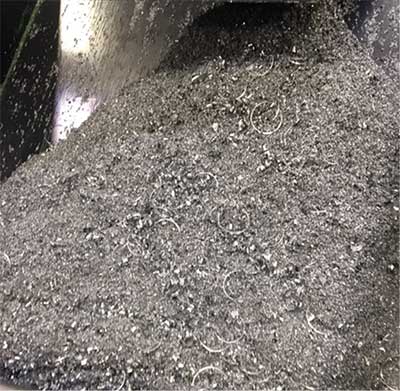
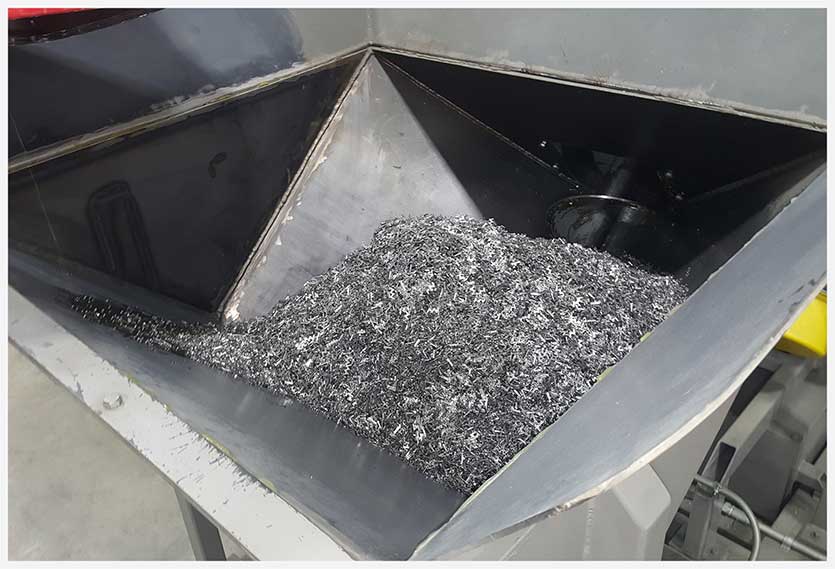
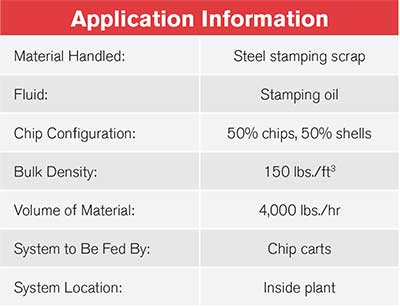
The installation of the PRAB Wringer/Centrifuge system achieved the following results for the powertrain manufacturer:
In addition to meticulously testing its equipment to prove its performance capabilities for every unique metalworking application, PRAB provides a Performantee® for every system it supplies, guaranteeing the equipment will achieve the specific results for which it is designed. PRAB’s “Prove It Before You Use It” approach to testing, combined with its performance guarantee, reflects its commitment to customers before, during, and after the installation of one of its automation systems. This level of partnership has proven to enhance operations for the powertrain supplier, who has plans to utilize PRAB for future automated equipment improvements.

System Feed Screw Conveyor
Diagonal Shaft Chip Wringer: Model 24CD
Settling Tank
Discharge Screw
Powered Swivel Chute
Control Panel
System Start-Up and Training
PRAB is a leading engineer and manufacturer of conveyors, chip and fluid management systems, and industrial water and wastewater treatment equipment. Our customized solutions automate metal handling, reduce labor costs, reclaim and recycle expensive cutting fluids/coolants and maximize return on recycling metals. With our expertise, honed by more than 4,500 installations for the world’s leading OEMs and suppliers, PRAB continuously improves material handling, housekeeping and compliance to environmental rules and regulations within the automotive, aerospace, medical, electronics, defense, off-road and energy markets. For more information about PRAB, visit prab.com.